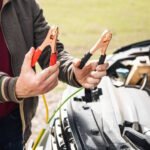While basic jump-starting knowledge can get you out of most battery emergencies, there are special situations that require advanced techniques. This comprehensive guide covers techniques for handling challenging scenarios, from extreme weather conditions to modern vehicle technologies.
Jump-Starting in Extreme Weather Conditions
Cold Weather Techniques
Cold weather significantly impacts battery performance and jump-starting procedures. At 32°F (0°C), a car battery loses approximately 35% of its strength. At 0°F (-18°C), this increases to a staggering 60% loss while the engine requires up to twice as much power to start.
Advanced cold weather jump-starting tips:
- Extended charging time: Allow the donor vehicle to run for 5-10 minutes before attempting to start the dead vehicle. This provides more initial charge to the cold battery.
- Protect the donor battery: Even a good battery works harder in cold weather. Don’t immediately shut off the donor vehicle after a successful jump-start; let both engines run for a few minutes to ensure both batteries stabilize.
- Indoor warming when possible: If your vehicle is in an extremely cold environment and can be safely moved to a warmer location (like a heated garage), even a brief warming period can significantly improve chances of a successful jump-start.
- Watch for frozen battery signs: If your battery has actually frozen (usually happens below -20°F/-29°C or in badly discharged batteries at less extreme temperatures), do NOT attempt to jump-start it. A frozen battery can explode when charged. Look for a bulging case or frost inside the cells if visible.
Hot Weather Considerations
Excessive heat presents different challenges for jump-starting:
- Battery expansion awareness: Heat can cause batteries to swell. If the battery case appears distorted or bloated, do not jump-start it. This condition indicates internal damage and potential danger.
- Cooling techniques: If the hood has been closed on a hot day, open it for a few minutes before connecting jumper cables to allow some heat to dissipate.
- Extra spark precautions: Hot batteries can release more hydrogen gas, increasing explosion risk. Be particularly careful about making proper connections.
- Fluid level verification: Hot weather increases water evaporation in traditional batteries. If your battery has removable caps and appears low on fluid, it should be serviced before jump-starting.
Advanced Techniques for Modern Vehicles
Jump-Starting Hybrid Vehicles
Hybrid vehicles typically have two separate battery systems:
- A high-voltage battery system that powers the electric motors
- A conventional 12-volt battery that powers accessories and the vehicle’s computer systems
Hybrid jump-starting procedure:
- Locate the 12V battery: In many hybrids, this isn’t under the hood but may be in the trunk or another compartment. Consult your owner’s manual for the exact location.
- Use designated jump points: Some hybrids have specific jump-starting connection points rather than direct battery access. Toyota Prius models, for instance, have a special jump-start terminal under the hood fuse box.
- Follow standard procedure with extra caution: Once you’ve located the 12-volt battery, the jump-starting procedure is similar to conventional vehicles. However, pay extra attention to connecting to the correct terminals, as hybrid electrical systems are more sensitive to improper connections.
- NEVER connect to high-voltage components: The high-voltage system in hybrids (usually indicated by orange cables or connections) should never be touched or connected to jumper cables.
Electric Vehicle Considerations
For fully electric vehicles:
- Most EVs cannot jump-start other vehicles: While you can jump-start an EV’s 12-volt battery from another vehicle, you generally should not use an EV as a donor vehicle to jump-start others.
- Follow manufacturer guidelines strictly: Each EV manufacturer has specific procedures for accessing and jump-starting the 12-volt battery. Some, like Tesla, require accessing the battery through the front trunk and following a precise sequence.
- Consider professional assistance: Due to the complexity and high voltage of EV systems, many manufacturers recommend calling for professional assistance rather than attempting a jump-start.
Vehicles with Start-Stop Technology
Modern vehicles with start-stop technology (which automatically shuts off the engine when stationary) use specialized AGM (Absorbed Glass Mat) or EFB (Enhanced Flooded Battery) batteries designed to handle frequent starting cycles.
Advanced techniques for start-stop vehicles:
- Use proper battery type as donor when possible: Ideally, the donor vehicle should also have an AGM battery if you’re jump-starting a vehicle with start-stop technology.
- Allow extra charging time: These specialized batteries often benefit from a longer charging period before attempting to start. Let the donor vehicle run for 5-10 minutes with cables connected.
- Expect system resets: After jump-starting, the start-stop system might temporarily deactivate itself. This is normal and usually resets after driving for 15-30 minutes or after the next time you start the car.
- Be aware of higher current requirements: Vehicles with start-stop technology typically draw more current when starting, so ensure your jumper cables are of sufficient quality (4-6 gauge recommended).
- Follow with complete recharge: After successfully jump-starting, these batteries should receive a full recharge either through extended driving (at least 30 minutes of highway driving) or with a proper battery charger rated for AGM batteries.
Self Jump-Starting Techniques
When there’s no second vehicle available to help, these advanced self-jump-starting techniques can get you back on the road:
Using a Portable Jump Starter Like a Pro
The most reliable method for self-jump-starting is using a portable jump starter, but there are advanced tips to maximize effectiveness:
- Position for optimal connection: Place the jump starter on a stable surface, not directly on the vehicle battery or engine, to prevent movement during the starting process.
- Pre-charge the dead battery: Some portable jump starters have a “pre-charge” or “boost” mode. Use this for 2-3 minutes before attempting to start the engine, especially for severely depleted batteries.
- Multiple connection attempts: If the first start attempt fails, disconnect the jump starter completely, wait 30 seconds, then reconnect and try again. This “reset” can sometimes resolve connection issues.
- Temperature considerations: In very cold conditions, warm the portable jump starter inside your vehicle for 10-15 minutes before using it. Cold temperatures significantly reduce a jump starter’s effectiveness.
- Monitor for overheating: High-quality jump starters have thermal protection, but still watch for excessive heating during use. If the unit becomes hot, disconnect it and allow it to cool before trying again.
Push-Starting Manual Transmission Vehicles
If you have a vehicle with a manual transmission, you may be able to push-start it:
Advanced push-starting procedure:
- Ensure proper conditions: This technique requires:
- Manual transmission vehicle
- Slightly sloped terrain or someone to help push
- Enough battery power to operate the ignition system
- Use second gear: While first gear can work, second gear often provides the optimal balance between wheel torque and engine RPM for successful starting.
- Coordinate pushing effort: If using helpers, ensure clear communication about when you’ll be releasing the clutch to prevent injuries.
- Clutch technique matters: When the vehicle reaches 5-10 mph, release the clutch quickly but smoothly—not abruptly. This creates the ideal mechanical advantage to turn over the engine.
- Immediate throttle application: As soon as the engine catches, apply light throttle while still holding the clutch to prevent stalling.
Advanced Troubleshooting for Difficult Jump-Starts
When Standard Jump-Starting Fails
If typical jump-starting procedures aren’t working, try these advanced troubleshooting techniques:
- Terminal cleaning during the process: If you notice corrosion on the battery terminals that’s preventing good connection:
- Disconnect cables
- Create a quick cleaning solution with water and baking soda
- Use a wire brush or tool to clean terminals
- Dry thoroughly before reconnecting
- Check for parasitic drains: If a vehicle repeatedly needs jump-starting despite driving sufficiently between starts, a parasitic drain might be present. Common culprits include:
- Trunk or glove compartment lights staying on
- Aftermarket electronics with improper installation
- Faulty alternator diodes
- Battery load testing: After jump-starting, have the battery load-tested at an auto parts store. This test measures the battery’s ability to hold voltage under load and provides more information than a simple voltage test.
- Alternator output verification: A properly functioning alternator should produce 13.8-14.4 volts when the engine is running. Lower output indicates charging system problems that will continue to drain your battery.
- Ground connection alternatives: If the standard grounding point isn’t providing good connection, try alternative metal points such as:
- Engine lifting brackets
- Alternator mounting brackets
- Frame rails (ensuring they’re clean, unpainted metal)
Post Jump-Start Battery Recovery Techniques
Properly caring for your battery after a jump-start can prevent future issues and extend battery life:
Advanced Recharging Protocol
- Strategic driving pattern: After jump-starting, drive at highway speeds (above 50 mph) for 30 minutes if possible. This higher engine RPM generates more alternator output than city driving.
- Electrical load management: For the first 20-30 minutes after jump-starting:
- Turn off high-draw accessories like air conditioning, heated seats, and audio systems
- Minimize headlight usage (drive during daylight if possible)
- Disable automatic features that cycle electrical systems
- Battery maintenance after recovery: Once the immediate crisis is over, perform these maintenance steps:
- Clean terminals with a proper battery cleaning tool
- Check cable connections for tightness and corrosion
- Apply terminal protectant to prevent future corrosion
- Consider using a battery maintainer for vehicles not driven daily
Professional Recovery Options
For batteries that have been deeply discharged, professional options provide better long-term outcomes:
- Multi-stage charging: Professional battery shops can perform a controlled, multi-stage charge that:
- Starts with a low current to “wake up” deeply discharged batteries
- Gradually increases to bulk charging
- Finishes with absorption and float stages to maximize capacity
- Desulfation treatment: Professional equipment can apply pulsed current to break down sulfate crystals that form during discharge, potentially recovering batteries that seem beyond help.
- Battery reconditioning: Some service centers offer battery reconditioning that:
- Restores electrolyte balance
- Removes sediment
- Rebalances cell voltages
- Can extend the life of an older battery
Conclusion
These advanced jump-starting techniques prepare you for virtually any battery emergency scenario you might encounter. While the basic process remains the same, these specialized approaches for various vehicles and conditions can make the difference between a successful jump-start and continued frustration.
Remember that regular battery maintenance is the best preventive measure. Test your battery every 6 months, keep terminals clean, and consider using a maintainer for vehicles not driven regularly. For vehicles older than 3 years, be proactive about replacement at the first signs of weakening, especially before extreme weather seasons.
By mastering these advanced techniques, you’ll have the confidence to handle even the most challenging battery situations, ensuring you’re never left stranded for long.



